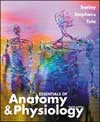 |
1 |  | 
Nerves and ganglia that transmit action potentials to smooth muscle, cardiac muscle, and glands for digestion are part of the |
|  | A) | PNS. |
|  | B) | efferent division. |
|  | C) | autonomic nervous system. |
|  | D) | parasympathetic division. |
|  | E) | all of these |
 |
 |
2 |  | 
A long cell process extending from the neuron cell body is the |
|  | A) | axon. |
|  | B) | dendrite. |
|  | C) | Nissl body. |
|  | D) | mitochondrion. |
|  | E) | neuroglia. |
 |
 |
3 |  | 
Most efferent neurons and most CNS neurons are |
|  | A) | bipolar. |
|  | B) | multipolar. |
|  | C) | unipolar. |
|  | D) | neuroglia. |
 |
 |
4 |  | 
Neuroglia that line fluid-filled cavities and produce and circulate cerebrospinal fluid are |
|  | A) | astrocytes. |
|  | B) | ependymal cells. |
|  | C) | microglia. |
|  | D) | oligodendrocytes. |
|  | E) | Schwann cells. |
 |
 |
5 |  | 
In the PNS, bundles of axons and their connective tissue sheaths are called |
|  | A) | gray matter. |
|  | B) | ganglia. |
|  | C) | pathways. |
|  | D) | nerves. |
|  | E) | nodes of Ranvier. |
 |
 |
6 |  | 
Which of these statements is true concerning local potentials? |
|  | A) | Local potentials must reach the threshold to cause an action potential. |
|  | B) | Local potentials travel throughout the whole nerve cell. |
|  | C) | A local potential occurs when potassium ion channels open and allow potassium ions to move into the cell. |
|  | D) | Local potentials move by saltatory conduction. |
|  | E) | Large negative molecules diffuse out of a cell during a local potential. |
 |
 |
7 |  | 
Which of these is NOT a neurotransmitter? |
|  | A) | acetylcholine |
|  | B) | acetylcholinesterase |
|  | C) | norepinephrine |
|  | D) | dopamine |
|  | E) | serotonin |
 |
 |
8 |  | 
Given these parts of a reflex arc: 1. afferent (sensory) neuron 2. efferent (motor) neuron 3. effector organ 4. association neuron 5. sensory receptor, Arrange the parts in the order an action potential would travel after a stimulus is received. |
|  | A) | 2,3,5,4,1 |
|  | B) | 3,5,1,2,4 |
|  | C) | 3,4,1,2,5 |
|  | D) | 5,1,4,2,3 |
|  | E) | 5,2,4,3,1 |
 |
 |
9 |  | 
Nuclei that control functions such as heart rate regulation, breathing, swallowing, vomiting, coughing, sneezing, balance, and coordination are found in the |
|  | A) | midbrain. |
|  | B) | pons. |
|  | C) | diencephalon. |
|  | D) | medulla oblongata. |
|  | E) | reticular formation. |
 |
 |
10 |  | 
The part of the brain that plays a central role in control of body temperature, hunger, thirst, and emotions, and connects to the pituitary gland is the |
|  | A) | pineal body. |
|  | B) | colliculi. |
|  | C) | hypothalamus. |
|  | D) | substantia nigra. |
|  | E) | pons. |
 |
 |
11 |  | 
The cerebellum |
|  | A) | is mainly concerned with speech. |
|  | B) | is the location for short-term memory. |
|  | C) | functions as a comparator between intended and actual movements. |
|  | D) | is primarily sensory in function. |
|  | E) | all of these |
 |
 |
12 |  | 
Almost all ascending pathways relaying information to the cerebrum terminate in the |
|  | A) | medulla oblongata. |
|  | B) | cerebellum. |
|  | C) | pons. |
|  | D) | thalamus. |
|  | E) | midbrain. |
 |
 |
13 |  | 
Cerebrospinal fluid is produced by the ______ and passes into the blood through the ______. |
|  | A) | cerebral aqueduct, arachnoid granulations |
|  | B) | choroid plexus, cerebral aqueduct |
|  | C) | arachnoid granulations, choroid plexus |
|  | D) | choroid plexus, central canal |
|  | E) | choroid plexus, arachnoid granulations |
 |
 |
14 |  | 
Which nerve plexus gives rise to the musculocutaneous, axillary, ulnar, radial, and median nerves? |
|  | A) | brachial plexus |
|  | B) | cervical plexus |
|  | C) | coccygeal plexus |
|  | D) | lumbar plexus |
|  | E) | sacral plexus |
 |
 |
15 |  | 
The sympathetic division of the autonomic nervous system |
|  | A) | has preganglionic cell bodies in the cranial and sacral regions. |
|  | B) | stimulates vegetative activities. |
|  | C) | has postganglionic cell bodies in terminal ganglia on or near the target organ. |
|  | D) | secretes norepinephrine from most postganglionic neurons. |
|  | E) | has many fibers in cranial nerve X. |
 |



 2002 McGraw-Hill Higher Education
2002 McGraw-Hill Higher Education